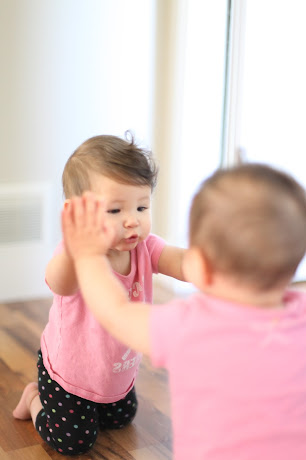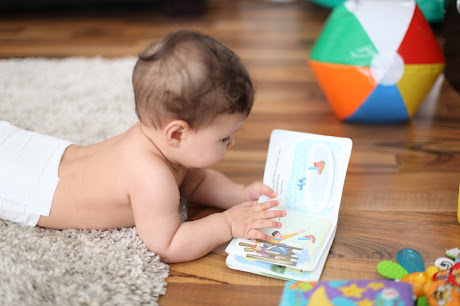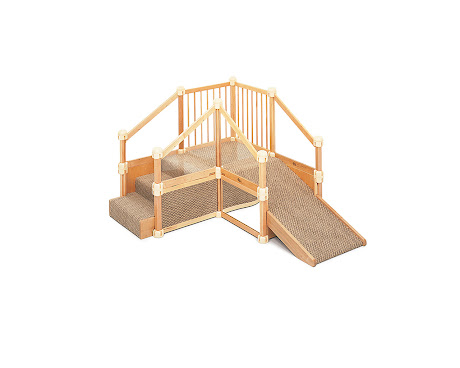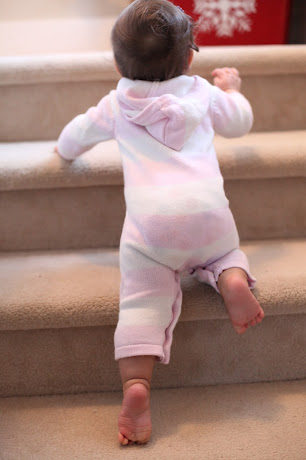—Dr. Silvana Montanaro, MD

Preparing for Movement with the Montessori Infant/Toddler Environment
Movement is important in all Montessori environments. In the infant/toddler environment, the attention is on strengthening muscles and developing gross motor skills. Developing movement in the youngest Montessori children also lays the foundation for future cognitive development. Children who are free to move and explore learn to pursue their own interests. And learning to move to get something just out of reach is a lesson in problem solving.
Movement mat
A movement mat is like a work mat for infants. It defines the infant’s space, not only for the infant but also for those around him. The infant’s movement mat is his safe place to lay and interact with a mobile or the wall mirror. Like a work mat, the movement mat can be moved around the room, but it is a consistent and delineated space for him to be on until he learns to crawl.

The movement mat provides a cushioned area between the infant and the floor. It can be as simple as a folded blanket or quilt, a thick yoga mat, or even a piece of covered foam (that is BPA and formaldehyde free). Remember to keep the movement mat as a defined “work” space — it is not intended as a space for napping, but as a place to wiggle and move. If the infant does fall asleep on the mat, move him to the sleeping area so he learns where to play and where to sleep.
Crawling and sitting
Crawling babies move quickly! Rotating objects on the infant shelves encourages the child to move and explore. Baskets of blocks, books, and other materials encourage the child to move to them. However, be sure to limit the number of materials available as infants are easily over-stimulated.
Cloth tunnels are another great addition to the environment that promote movement. Place the tunnels throughout the room to encourage infants to crawl through them, creating a safe and fun way to explore.

Pulling up and walking
Toddler pull up/cruising bars should be securely attached to along the wall at pull-up height, about 17.5 inches (about 44 cm) from the floor. The bars help strengthen the child’s leg muscles while providing the toddler with support. Toddlers may also use these bars and low, sturdy shelving to ‘cruise’ around the environment. Small ride-on toys that are propelled by pushing with the legs also strengthen the child’s lower body. Walker wagons that can be pushed or pulled provide another opportunity for the child to practice walking, like this wagon from Ikea.

Climbing
Once mobile, toddlers are on their way to climbing — and they love climbing stairs. Because of this, Montessori caregivers often teach toddlers the proper and safe way to ascend and descend stairs. Many Montessori infant/toddler environments have a small set of stairs to practice going up and down. Some include a ramp and even a small slide to add to the fun. (See an example below from Community Playthings.) Learning to climb properly is Practical Life for toddlers!


- Infant swings
- Jumpers/walkers
- Play pens/play yards
- Cribs (see the NAMC blog Helping Parents Create an Effective Infant Toddler Montessori Home Environment for more information on Montessori floor beds)
Jumpers and walkers may seem to be strengthening muscles, but they teach the child to move artificially and movement must be relearned. In fact, the use of baby walkers was banned at childcare centers by the American Academy of Pediatrics due to the overwhelming number of injuries they cause each year. Just as we should not inhibit movement, nor should we rush it. Each child develops in his own time. To assist the child by holding him upright to help him walk sends the message that he is not ready or that we are not satisfied with his progress.
The Montessori infant/toddler environment offers a prepared, well-planned space for children to learn and grow. With attentive, respectful supervision, Montessori infants and toddlers freely move about their environment, sensorially exploring and learning along the way.
As much as possible, NAMC’s web blog reflects the Montessori curriculum as provided in its teacher training programs. We realize and respect that Montessori schools are unique and may vary their schedules and offerings in accordance with the needs of their individual communities. We hope that our readers will find our articles useful and inspiring as a contribution to the global Montessori community.
As much as possible, NAMC’s web blog reflects the Montessori curriculum as provided in its teacher training programs. We realize and respect that Montessori schools are unique and may vary their schedules and offerings in accordance with the needs of their individual communities. We hope that our readers will find our articles useful and inspiring as a contribution to the global Montessori community.
© North American Montessori Center - originally posted in its entirety at Montessori Teacher Training on Friday, August 16, 2013.
© North American Montessori Center - originally posted in its entirety at Montessori Teacher Training on Friday, August 16, 2013.

0 comments:
Post a Comment
Have questions or comments? Let us know what you thought about this article!
We appreciate feedback and love to discuss with our readers further.